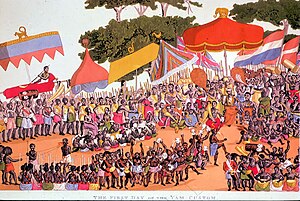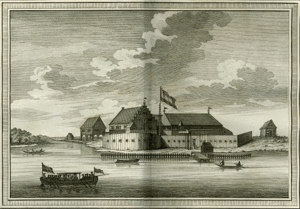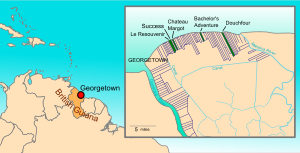Coromantee
Coromantee or Coromanti people , also Coromantins, was the name in the Caribbean for the last enslaved people from the Gold Coast , today's Ghana . Because of their military background and the common Akan language , the Coromantee organized dozens of slave revolts in Jamaica and elsewhere in the Caribbean. Their harsh and rebellious nature was so notorious among white plantation owners in the 18th century that a law was proposed to ban the importation of people from the Gold Coast, despite their reputation as hardworking workers.
etymology
The name is derived from the Ghanaian coastal town of Kormantse and is the English name for members of the Akan ethnic group . The name is now considered out of date and was and is used exclusively in the Caribbean.
origin
In the Caribbean, especially Jamaica, slaves who came from the Gold Coast, today's Ghana, were referred to as Coromantee. The slaves came from different ethnic groups of the Akan ethnic group, such as the Ashanti , Fante or Akim . The Akan people had the greatest cultural influence in Jamaica. The Maroons widespread there are descendants with cultural and linguistic roots of the Akan.
history

In the 17th and 18th centuries, the British Gold Coast colony increasingly bought enslaved Africans from the Ashanti people. Due to frequent wars between the individual Akan groups, however, the Ashanti themselves were also enslaved, as were Fante and other prisoners of war of the individual Akan peoples. The slaves were brought to Caribbean colonies, primarily Jamaica, which has the highest percentage of people from this region. White slave owners began to distinguish Africans according to their place of origin. They further delimited their ethnic origin through behavior and characteristics. The term coromantee was interpreted as the region where the people came because they shared a common language, the Akan - language Twi [ t͜ɕʷi ]. This functioned as the basis for a loosely structured organization of people who socialized and helped each other. Although the people shared a political language, the Coromantee were made up of around 40 different peoples with different cultures and mythologies. One of them are the stories about Anansi . These are still very popular in Jamaica today and are called Anansi Drew or Br'er Rabbit stories there. These stories are also in the Bahamas and the southern states of the United States known. Another custom that has survived in the New World is the tradition of naming children by the day of the week they were born.
Rebellions, uprisings
1690
There were several riots attributed to the Coromantee around the 1700s. The first historically secured in Jamaica took place in the Parish Clarendon in 1690 . After 200 to 300 slaves had killed a white plantation owner, they came into possession of firearms. They then killed a guard in a neighboring plantation. A militia was formed to suppress the rebellion. Some of the insurgents escaped and joined the Maroons . However, the leader was caught and then hanged.
An incident is also described where some Coromantee killed a white slave owner, then beheaded him and used his head as a drinking bowl.
1736 - Antigua slave rebellion
In 1736 a slave with the nickname Prince Claas and the slave name Curt planned an uprising in Antigua in which people of white skin color were to be killed. In a pasture outside the capital of Saint John . White observers reported a colorful traditional spectacle, unaware that it was a ritual declaration of war on the white oppressors. During the event, Prince Claas was awarded the title of King of the Coromantees . However, information from other slaves revealed the conspiracy. Prince Claas and four of his followers were captured and then to death gerädertverurteilt . Six other slaves were hung in chains and starved to death. 58 slaves were burned at the stake.
1760 - Tacky's War
In 1760, a group of slaves led by a Fante man named Tacky entered the port of Port Maria , Jamaica. They captured muskets, gunpowder and bullets. Hundreds of slaves had joined him the following morning. They moved inland and pillaged and destroyed one plantation after the other. They killed most of the plantation owners and many fair-skinned residents. They were also able to conquer several ammunition depots in and around Port Maria. After more than a month the revolt was suppressed by two English companies of soldiers. The leader Tacky was shot from behind in battle. About 300 slaves were later executed. However, many of the insurgents were able to flee into the mountains and there joined the Maroons. This uprising is considered the largest slave uprising in Jamaica and the second largest in the entire Caribbean after the Haitian Revolution .
1763 - Berbice slave revolt
The slave revolt of Berbice in what was then Dutch Guiana began on February 23, 1763 and could only be suppressed in the second half of 1764. At the beginning of the uprising, the colony numbered around 350 whites (including women and children) and almost 4,000 African slaves. In February 1963 the first plantations were attacked under the leadership of Coromantee Cuffy , who previously worked as a house slave in Lelienburg . The rebels were able to steal weapons and ammunition. The white settlers initially sought protection in Fort Nassau , which was quickly abandoned because of its poor condition. The survivors fled to the St. Andries military post. From there they finally received help from the Dutch governor van Hogenheim. Although the rebels were in the majority, they could not agree on a unified line against the Dutch colonial rulers . While Cuffy advocated a division of the country (whites on the coast, blacks inland), his deputy Akara pursued an aggressive tactic. After the slaves are defeated in a battle against them, internal fighting ensues in the slave army. Cuffy is subject to his previous deputy Akara and commits suicide. At the end of December 1763, six military ships arrived from Europe to retake the colony. Around 40 whites and around 1,800 Africans were killed in the fighting.
The uprising had failed mainly because of quarrels among the slaves. However, it was the first serious attempt by a large group of African slaves to create a free land for freed slaves in the New World.
1765 - conspiracy
In 1765, two Coromantee leaders named Blackwell and Quamin or Kwame planned an uprising to subdue and divide the island of Jamaica. They wanted to ally themselves with the people of the Maroons who should keep the forests as an administrative area. The Coromantee themselves should take care of the management of the usable areas. Blackwell and Quamin entered a fort near Port Maria . They ambushed soldiers and then killed them. Several white citizens also fell victim to them. They were then betrayed to the British authorities by the Maroons, who did not agree to the contract to split them up.
1816 - Bussa Rebellion
The Bussa Rebelion took place in Barbados in 1816 . Barbados at that time was a central market for slaves from the Gold Coast , today's Ghana. From there, slaves were imported and dispersed into the various British colonies . Mostly to Jamaica and Guyana . The importation of slaves from the Gold Coast took place from the 17th to the 19th centuries. On April 14, 1816, a revolt began led by a slave named Bussa. About 400 former slaves carried out the uprising. However, this failed due to the superior firepower of the whites. Bussa was killed in the battle. This revolt sparked a discussion that finally, in 1833, the British colonial masters initiated the Act. To be enacted in 1833, which included the abolition of slavery.
1822 - Vesey plot
In 1822, many slaves were deported from the Caribbean to the United States . Among them was a Coromantee called Denmark Vesey or Telemaque . He planned a revolution to take place on July 14th, the date of the French national holiday . Together with his co-conspirators, he planned to kill the slave owners and, in order to escape the reprisals, sail them to Haiti afterwards. The plan became popular among slaves throughout Charleston and along the Carolina coast . Before it was carried out, however, the insurgents were betrayed by two slaves who did not agree with Vesey's ideas. The authorities then arrested 131 insurgents. 67 of them were convicted. 31 former slaves were hanged, including Denmark Vesey.
1823 - Demerara Rebellion
The Demerara Rebellion in Guyana was one of the largest slave revolts in the British colonies before slavery was abolished in 1833. The uprising was directed and planned by a Coromantee slave living there by the name of Quamina (Kwamina) Gladstone and his son Jack Gladstone. Quamina led tens of thousands of slaves, in and around George Town , into a revolution designed to peacefully rebel against ill-treatment and poor conditions. However, this resulted in a major battle at Bachelor's Adventure, east of George Town. Gladstone, his son and several other slaves were able to flee into the woods. A reward of 1,000 guilders was offered for their capture and that of about 20 other slaves . Jack Gladstone and his wife were on September 6 after a standoff that lasted three hours by Captain McTurk at Chateau Margo captured. Quamina remained undiscovered for the time being until he was tracked down on September 16, also in the area of Chateau Margo. Both were executed and their bodies were pinned to a wall in a busy street as a deterrent.
See also
Individual evidence
- ^ A b c Warfare in Atlantic Africa, 1500-1800 , John K. Thornton (1999), University College of London Press / Routledge
- ↑ a b Coromantee and Maroons in Jamaica (OrijinCulture.com)
- ↑ a b Joseph A. Opala: The Gullah: Rice, Slavery and the Sierra Leone-American Archived from the original on May 17, 2006. Information: The archive link was automatically inserted and not yet checked. Please check the original and archive link according to the instructions and then remove this notice. In: yale.edu . September. Retrieved October 12, 2014.
- ↑ a b c d e f g h i Edward Long: The History of Jamaica Or, A General Survey of the Antient and Modern State of that Island . (Google Books) In: Google Books . 2, No. 3/4, 1774, pp. 345, 445-475.
- ↑ a b c History of Port Maria at VisitJamaica.com ( Memento of the original from July 15, 2013 in the Internet Archive ) Info: The archive link was inserted automatically and has not yet been checked. Please check the original and archive link according to the instructions and then remove this notice.
- ↑ a b c The Vesey Revolt ( Memento of the original dated November 13, 2014 in the Internet Archive ) Info: The archive link was inserted automatically and has not yet been checked. Please check the original and archive link according to the instructions and then remove this notice. (www3.GettysBurg.edu)
- ↑ Cécile Révauger: The Abolition of Slavery - The British Debate 1787-1840 (Presse Universitaire de France, 2008) , ISBN 978-2-13-057110-0 .
- ↑ a b c d Joshua Bryant: Account of an insurrection of the negro slaves in the colony of Demerara, which broke out on the 18th of August, 1823 . (Google Books) In: Google Books . 2, No. 3/4, 1824, pp. 83-84, 87-88, 180.


